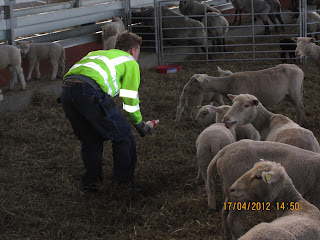Perhaps this picture is a little too dark but it shows a lesson when we look at a skeleton from a horse. It is great to have the skeleton i a classroom, it is so easy to compare with a real horse in the stable nextdoor and provide a greater understanding for horses physique.
Here is a nice picture showing a student feeding a lamb. Our school has the past winter build a new sheep barn. The staff and students are very happy to have it because we can have more sheep.
Okey, this is a hazy picture, but I would like to view it because it shows when at student clean a cow. Some of the students is not really used to work with cows so I think it is a very good exercise to get comfortable and friend with the ladys. At the school we have about 55 cows and they are not tied up and for some of the students it is quite scary to go in to the big animals even if the staff says that the cows is very kind.



i love the fact that the cows are loose and not tied up in a stable or barn. what is the procedure when you milk the cows though?
SvaraRaderaYes, I think that it is better for the cows too be loose. We have three groups of about 18 - 21 cows in each. We let them go to the milk parlour half past 5 in the morning and 3 in the afternoon. It is important that it is the same cows i the group when they goes back after milking.
RaderaThe milkparlour hold 12 cows, 6 at each side. First we clean the mammary and take some milk i plastic jar to check that it is ok and to prepare for milking. When the milk is empty the milk machine puts of automatic. When all the six cows on the side is ready they can go back and eat or relax.
Yes cows can be a bit scary when you see them up close. Our cows seem very big in Australia. Do you teach them safety when working with cows? How do you go about teaching this?
SvaraRaderaI work as a teacher for students having i bit lower IQ, in Sweden we call it särskola, special school. They have very different capacity and we have to adjust the education to each student. Most of this students are a bit afraid of the animals because that they can't "read" the animals and understand why they reacting as they do, and a cow is at big animal. My tactics is, as you can see at the picture, just being in the group and clean them, pat them and look at them. When they at milking it is not very much contact because the are down in the milkparlour and it is like fens between them and the cows. It have to take the time it takes. Some of the students is like all of the other students and some of them, I think, is not able to go out to a employment. I think it is good to see them develop.
RaderaHello! I think this is a wonderful oppoartunity for your students, socially, emotionally and of course learning the content in a curriculum. What is the course called and how many of the students get a grade in the course?
RaderaYes it is true! Especially the socially training. I think it is the most difficult for our students.
RaderaThe course is called Natural Resources and it includes subjects like cultivation, farm animals, horseknowledge, welding and other similar subjects.
Many off our students go out into the world of work and are very skilled in their specialty. Some off them are not able to get to a real jobb but they often come to a place for practice but the employers do not pay the salary.
Christina many thanks for your blog post and I agree with Ingrid that your students have wonderful opportunities to learn in this environment.Caring for animals teaches us a lot I think. I also think that it is good to build the confidence of the students and sometimes this takes a lot of time.If your students dont go to employment when they are finished their course where do they go to next?
SvaraRaderaI think you have reed the answer to Ingrid over here but we also have students which are not capable to go to any type of emploument, even if the salary is payed of the state. It is difficult for them to come in to the labor. They often lives in any group homes whith staff and during the days at daily activities.
RaderaI understand now Christina. We have students like this and it takes a very special kind of teacher to work with these students and a lot of patience. I think your teaching strategies are excellent and getting them to know the animals by working with them is a good method.It is lovely to see students develop as you said. Where do the students go after they have finished their course? Do they stay in the school ?
SvaraRaderaIt depends on the students capability. Some students go out to a job, maybe the employer get some contribution with the salary. The students, who are not capable to do a real job is more difficult, often they lives in a group homes with stuff all day. On days they go to some sort off activity, it can be park management, at a café or something else.
SvaraRaderaOur students goes four years at our school, the other students goes three years.
The special schools students lives at the school, we have a residential with stuff all day from monday to friday. The weekends everybody goes home.